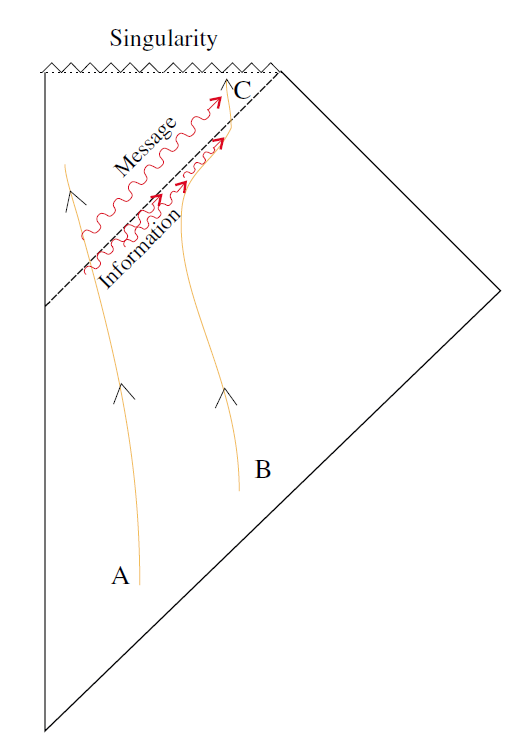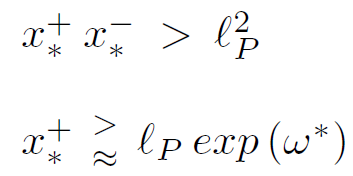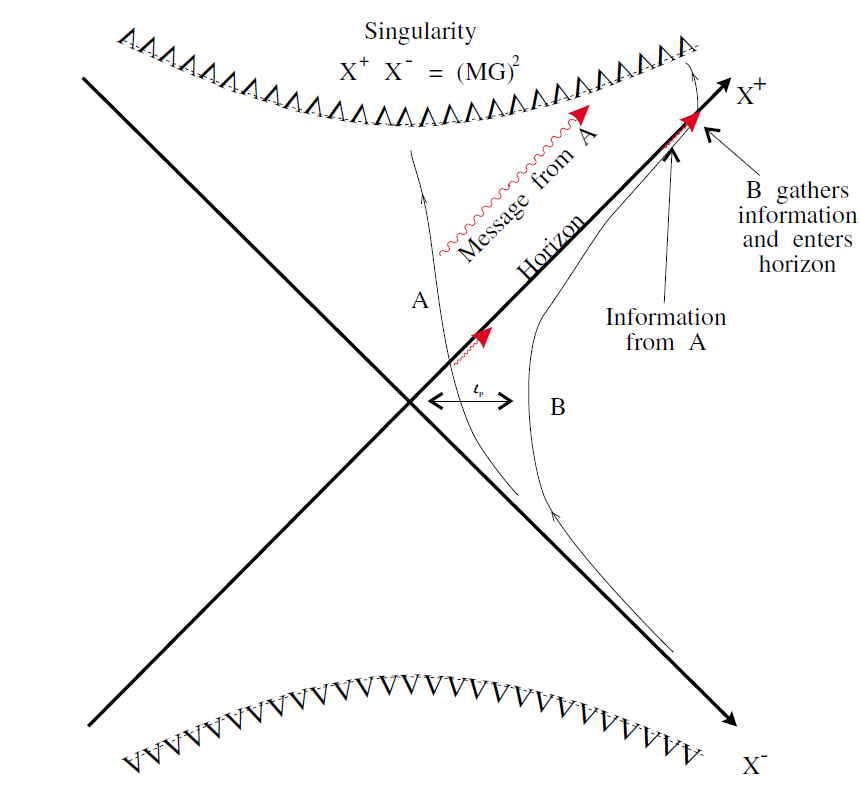


 الفيزياء الكلاسيكية
الفيزياء الكلاسيكية
 الكهربائية والمغناطيسية
الكهربائية والمغناطيسية
 علم البصريات
علم البصريات
 الفيزياء الحديثة
الفيزياء الحديثة
 النظرية النسبية
النظرية النسبية
 الفيزياء النووية
الفيزياء النووية
 فيزياء الحالة الصلبة
فيزياء الحالة الصلبة
 الليزر
الليزر
 علم الفلك
علم الفلك
 المجموعة الشمسية
المجموعة الشمسية
 الطاقة البديلة
الطاقة البديلة
 الفيزياء والعلوم الأخرى
الفيزياء والعلوم الأخرى
 مواضيع عامة في الفيزياء
مواضيع عامة في الفيزياء|
Read More
Date: 16-12-2015
Date: 2-2-2017
Date: 13-12-2015
|
Black Hole Complementarity
In its simplest form, black hole complementarity just says that no observer ever witnesses a violation of a law of nature. Thus, for an external observer it says:
A black hole is a complex system whose entropy is a measure of its capacity to store information. It tells us that the entropy is the log of the number of microstates of the degrees of freedom that make up the black hole. It does not tell us what those micro-degrees of freedom are, but it allows us to estimate their number. That number is of order the area of the horizon in Planck units.
Furthermore, it tells us that the micro-degrees of freedom can absorb, thermalize, and eventually re-emit all information in the form of Hawking radiation. At any given time, the fine grained entropy of the radiation field (due to entanglement) cannot exceed the entropy of the black hole. At the end of evaporation, all information is carried off in Hawking radiation.
For a freely falling observer, black hole complementarity tells us that the equivalence principle is respected. This means that as long as the black hole is much larger than the infalling system, the horizon is seen as flat featureless space-time. No high temperatures or other anomolies are encountered.
No obvious contradiction is posed for the external observer, since the infalling observer cannot send reports from behind the horizon. But a potential contradiction can occur for the infalling observer.

Fig. 1.1. Information exchange from External to infalling observer.
Consider a black hole, shown in Figure 1.1 along with an infalling system A. System A is assumed to contain some information. According to observations done by A, it passes through the horizon without incident.
Next, consider an observer B who hovers above the black hole monitoring the Hawking radiation. According to assumption, the photons recorded by observer B encode the information carried in by system A. After collecting some information about A (from the Hawking radiation ), observer B then jumps into the black hole. We don't actually need observer B to decode the information. All we really need is a mirror outside the black hole horizon to reflect the Hawking radiation back into the black hole.
We now have two copies of the original information carried by A. We can imagine A sending a signal to observer B so that observer B discovers the duplicate information at point C in Figure 1.1. Now we have a contradiction, since observer B has discovered a quantum Xeroxing of information from observer A. If this experiment is possible, then black hole complementarity is not self-consistent. To see why the experiment fails, we need to remember that no information will be emitted until about 1/2 the entropy of the black hole has evaporated. This takes a time of order
 (1.1)
(1.1)
Let us also assume that the observer B hovers above the horizon at a distance at least of the order of the Planck length ℓP. In other words, observer B hovers above the stretched horizon. This means that observer B's jump off point must correspond to Rindler coordinates satisfying
 (1.2)
(1.2)
In terms of the light cone coordinates x± = ρe±ω we have
 (1.3)
(1.3)
From Figure 1.2 we can see why there might be a problem with the experiment. Observer B might be forced to the singularity before a message can arrive. In fact, the singularity is given by
 (1.4)
(1.4)
Thus, observer B will hit the singularity at a point with
 (1.5)
(1.5)
The implication is that if A is to send a signal that B can receive, it must all occur at x− < (MG) e−ω∗. This means that A has a time of order Δt ≈ (MG) e−ω∗ to send the message.

Fig. 1.2. Resolution of Xerox paradox for observers within horizon.
Now, in the classical theory, there are no limits on how much information can be sent in an arbitrarily small time with arbitrarily small energy. However in quantum mechanics, to send a single bit requires at least one quantum. Since that quantum must be emitted between x− = 0 and x− =MGe−ω∗, its energy must satisfy
 (1.6)
(1.6)
From equation 1.2 we see that this energy is exponential in the square of the black hole mass (in Planck units) E > eM2 G/MG . In other words, for observer A to be able to signal observer B before observer B hits the singularity, the energy carried by observer A must be many orders of magnitude larger than the black hole mass. It is obvious that A cannot fit into the horizon, and that the experiment cannot be done.
This example is one of many which show how the constraints of quantum mechanics combine with those of relativity to forbid violations of the complementarity principle.



|
|
|
|
للعاملين في الليل.. حيلة صحية تجنبكم خطر هذا النوع من العمل
|
|
|
|
|
|
|
"ناسا" تحتفي برائد الفضاء السوفياتي يوري غاغارين
|
|
|
|
|
|
|
ضمن مشروع الورود الفاطمية بنسخته السابعة شعبة الخطابة النسوية تقدّم محاضرات إرشادية لعدد من المدارس المشاركة في حفل التكليف الشرعي
|
|
|